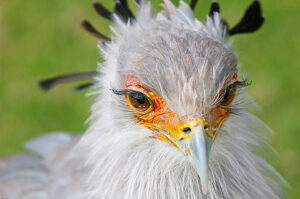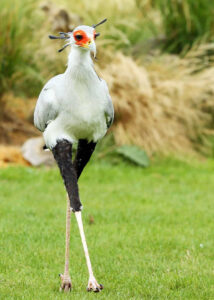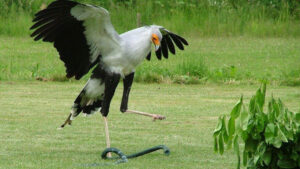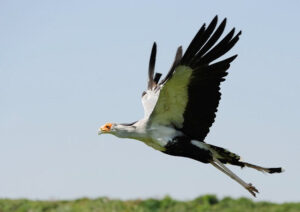The Secretary Bird: Africa’s Snake-Stomping, Long-Legged Raptor
Meet the secretary bird, a striking African raptor that prefers walking to flying and has a serious knack for snake hunting. With its towering legs, dramatic crest, and unique hunting style, this bird is as fascinating as it is fierce.
A Bird With a Name as Unique as Its Look
The name “secretary bird” might sound strange, but it has quirky historical roots. When Europeans first saw this bird in the 1800s, they were reminded of office secretaries of the time—men in gray tailcoats and black knee-length trousers who tucked quill pens behind their ears. The bird’s long gray feathers, trailing black leg plumes, and crest of quill-like feathers gave off a similar vibe. It’s a fun comparison that has stuck, even though the bird has nothing to do with paperwork! Despite its unusual appearance, the secretary bird is a fierce hunter. It belongs to the raptor family, distantly related to birds like vultures, buzzards, kites, and harriers. But unlike its high-flying cousins, the secretary bird does most of its work on the ground.

Ground-Dwelling Raptor With Sky-High Skills
Though secretary birds spend most of their time striding through the grasslands, they are capable fliers. These birds nest and sleep in the branches of acacia trees, flying up at dusk and soaring down to the ground again at dawn. In flight, their long legs dangle behind them in a distinctive silhouette. Secretary birds thrive across sub-Saharan Africa—from Senegal to Somalia and as far south as South Africa. Standing over four feet tall, they prefer open savannas with sparse trees and short grass, giving them a clear view of their surroundings. Each day, they patrol up to 20 miles (32 km) of their territory, which can span as much as 19 square miles (50 sq km). They are primarily solitary hunters or work in pairs, moving in a measured, methodical pace while scanning for prey. These birds have a varied diet, including lizards, birds, rodents, and large insects—but they’re best known for their prowess in taking down snakes, even the venomous ones.

Stomping, Striking, and Surviving
Secretary birds have two main hunting techniques: they either strike with their sharp beak or stomp their prey with tremendous force using their long, strong legs. Their flapping wings and raised crest can startle or distract prey, especially snakes, which often strike at the bird’s feathers—harmless targets that offer excellent protection. Their feet aren’t built for grasping like an eagle’s talons; instead, secretary birds kill or stun their prey and eat it right away or carry it in their beaks. They also take advantage of natural events—like wildfires—to scavenge for disoriented or injured animals. Their prehistoric hunting behavior has drawn comparisons to extinct “terror birds,” large flightless predators that used similar striking methods millions of years ago. The secretary bird is a living link to those ancient giants. At the San Diego Zoo and Safari Park, these birds are fed a mix of thawed mice and specially formulated carnivore food, mimicking the protein-rich diet they consume in the wild.

From Aerial Courtship to Treetop Nurseries
Secretary birds breed year-round, depending on food availability. Their courtship involves dramatic displays of soaring, swooping, and midair talon clasping. Once bonded, the monogamous pair builds a massive nest—sometimes as wide as 8 feet (2.4 meters)—high in a tree, using sticks, fur, dung, and leaves. These nests are reused and renovated over many seasons. The female lays one to three pale green eggs, spaced a few days apart. She does most of the incubating, while the male hunts and helps feed the young. Chicks hatch at intervals, but unlike many birds of prey, secretary bird parents can successfully raise multiple chicks at once. At first, the parents regurgitate soft food for the chicks. By 40 days, chicks can manage small meat pieces dropped into the nest. They start flapping and strengthening their wings around nine weeks and fledge—usually with an awkward tumble to the ground—by 12 weeks. After fledging, they stay close as their parents teach them to hunt, kick, and fly.

Calls, Communication, and Chick Protection
Secretary birds are generally quiet but do have a range of vocalizations. A loud croak or guttural roar might be heard during courtship or in defense of a nest. Alarm calls include high-pitched croaks, while mates communicate with softer whistles and clucks. Young chicks beg for food with soft cheeping that grows louder and more demanding as they mature. Treetop nests are vulnerable to predators like crows and kites, which may try to snatch chicks. Secretary bird parents remain vigilant, defending their young with sharp beaks, flailing wings, and stomping feet.





